Denon AVR-X1800H
Product Name: Denon AVR-X1800H
Product Description: 7.2 CH 8K AV Receiver
-
Design - 8.9/10
8.9/10
-
Audio Quality - 9/10
9/10
-
Inputs / Ports - 9.2/10
9.2/10
-
OS, Apps and Features - 9.1/10
9.1/10
-
Price / Quality - 9.2/10
9.2/10
Summary
Reviewed at $749.00
Pros
- Great cinematic sound
- Three 40Gbps HDMI 2.1 ports
- A lot of features
- Affordable price
Cons
- Almost the same as the X1700H
- Same old design
- Audyssey MultEQ Editor app not free
- No front HDMI input
Cheapest Places to Buy :
*We are a reader-supported website. When you buy through links on our site, we may earn a small affiliate commission at no extra cost to you. Home Media Entertainment does not accept money for reviews.*
Introduction
It is very common for AV receiver brands to partially refresh their lineup with each passing year. And Denon is one prime example of that trend. While in 2022 they refreshed a big part of their X-series, there were a couple of models missing. Finally this changed this year. And in our Denon AVR-X1800H review we are going to test their most affordable X-series AV receiver available right now.

The X1800H was announced and released in the second half of 2023. Along with a couple of AV receivers that belong in the S-series, and which we are going to review very soon. This new model is supposedly replacing the 2021 Denon AVR-X1700H. And the real question is, are there any meaningful differences between the two? Not really, but we will go more in detail about that shortly.
Firstly, let’s take a quick look at the specs. This is a 7.2 channels unit with 80 watts of power. It supports Dolby Atmos and DTS:X along with the usual virtual and up-mixing tech like Dolby Surround, DTS Neural:X, Dolby Atmos Height Virtualization and DTS Virtual:X. It uses Denon’s Audyssey MultEQ XT auto calibration system. And features plenty of extras like High Resolution Audio, HEOS, AirPlay 2, voice control, custom integration, HDMI upscaling and three HDMI 2.1 ports.
All the above sound incredibly similar to the X1700H. We failed to find any meaningful differences between the two so we have to go deeper and check everything in order to determine if Denon did try to change anything, or the new X1800H is more of a re-release to the 2021 model.
Design
Looks and Dimensions
With Marantz going over a complete design overhaul of their entire lineup, we hoped Denon would follow. But so far this is not the case. So we are in essence stuck with the same old design from previous years. As such the new X1800H comes with the same look the X1700H has.
The unit measures exactly the same at 17.1″ × 6″ × 14.3″ (434 mm × 151 mm × 339 mm) with the antennas in horizontal position. This way you save some space without any actual loss of the wireless signal. As for its weight, this was measured 19 lbs (8.6 kg). Which is just about what to expect from an AV receiver of this category.
Front Layout
Denon’s design keeps no surprises. Featuring straight lines and sharp corners this is your typical black box receiver that looks uninspiring, even a bit outdated compared to the competition. The front face features a brushed metal texture with an exact shame layout as the previous lower tier X-series models, including the X1700H.
This means a big central display showing all functions with two big circular knobs at each side. One for volume on the right and source selection on the left. Under the source selection knob we find the power button. While a thin line under the central display houses 10 function buttons. These are for tuner and zone 2 controls, Dimmer, Status and four quick select buttons.
Under these buttons, as usual, we get the front ports. There is a headphones jack and setup microphone port on the left and a single USB port on the right. That one can be used to stream audio from a USB based external storage like a flash drive.
Unfortunately there is still no front HDMI port in this lower tier units, which is a shame. We urge Denon to bring this very practical feature back in the future. Let’s hope they do whenever the next design revision happens.
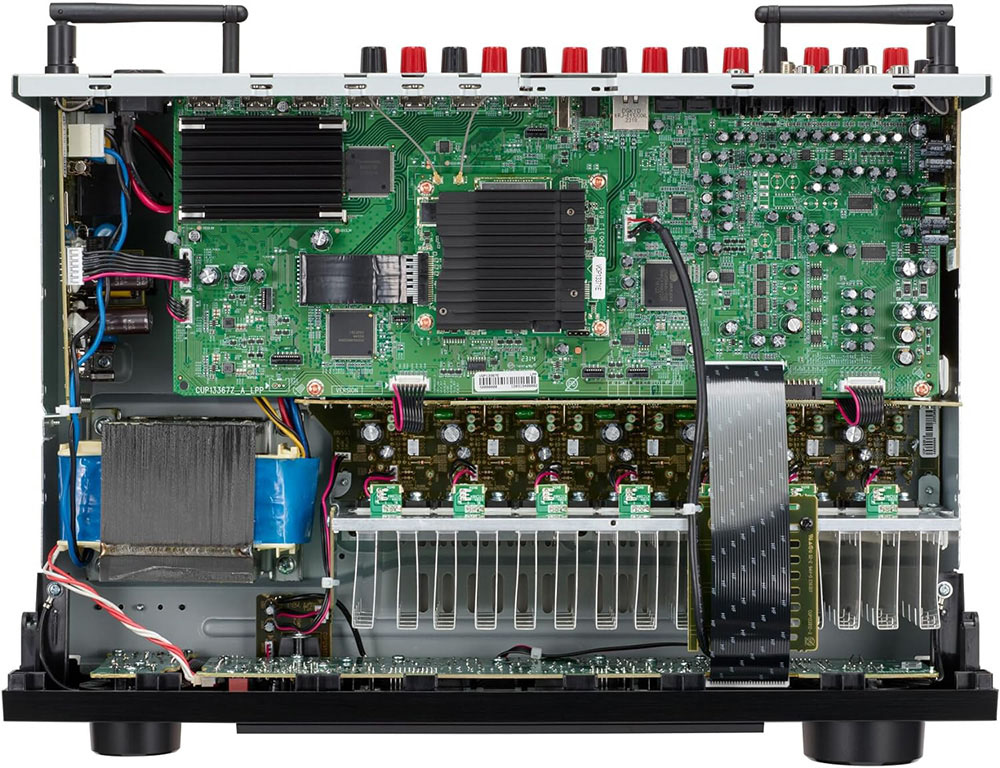
Internal Hardware
Next we will take a look at the insides of the unit.
The receiver features discrete high-current amplifiers on all channels with low-impedance drive capability. It uses a 32-bit Texas Instruments PCM5102A DAC for high resolution audio decoding up to 192 kHz / 24-bit. This provides low distortion and the widest possible dynamic range.
Remote
As for the remote, the one we found in the AVR-X1800H is codenamed RC-1257. Although at first glance it looks similar to the one included in the X1700H, there are a couple of minor changes.
The remote comes with all the input buttons at the top along with the HEOS and Bluetooth functions. Navigation buttons are in the middle along with channel and volume controls. While playback, quick selection and sound mode buttons are being placed at the bottom.
The remote in general is a big one. While the buttons have a relatively small size and we would like them a little bigger to be easier to the touch. At least the long distance between them minimizes the risk of a wrong command. Which can be a regular phenomenon in a dark environment since the remote lacks any kind of backlight functionality. Its construction is good and feels pretty solid with a nice texture on top to make it look a little bit more premium.
The changes we get in this year’s version is that Denon took out the Eco button. They also changed the sound mode buttons at the bottom from colored ones to single white color.

Audio Specifications
In terms of audio formats we get the usual so no real surprises here either. All low and mid tier Denon AV receivers come with almost the same support in terms of audio formats. So don’t expect to get some of the more exotic features we see in the premium category.
The receiver supports Dolby Atmos and DTS:X object oriented audio. But along with these we get support for up-mixing and virtual technology in order to cover all needs and specific room configurations.
Virtual Sound & Up-mixers
When it comes to up-mixing tech we get Dolby Surround and DTS Neural:X. What these up-mixers do is to up-convert stereo and legacy mixes in order to make use of all the speakers you have in your setup.
As for virtual tech, the Dolby Atmos Height Virtualization and DTS Virtual:X virtualizers are capable of creating sounds that originate from virtual created speakers around your room where there are no physical speakers present.
These virtual technologies obviously are not as good or accurate as having real physical speakers and are very much room dependent. Also the sound many times can be heard very over-processed, something we were never very fond of.
What is missing is Auro-3D along with IMAX Enhanced. These are only being included in the AVR-X3800H and above.

Internal Amplification
The AVR-X1800H comes with 7 channels of built-in amplification. Each channel is capable of outputting 80 watts of power (8 ohms, 20 Hz – 20 kHz, THD 0.08%, 2ch drive) which is enough for most small to mid sized rooms. Keep in mind that this is only for 2 channels driven. This means that when all 7 channels are active this number goes down considerably. The receiver cannot process more channels so this is the maximum it can do.
It can also support up to two subwoofers which is the standard nowadays. But surely not the best as many new units can even support up to 4 subwoofers. But two is more than enough for most casual users. So you should be fine in that respect.
With the built-in amplifiers you can go for either a 7.2 or a 5.2.2 channels audio setup with two dedicated Atmos speakers. As for this review we used a more modest 5.1.2 channels setup.
Movies Testing
Time for our real world testing and for this review we tried Bumblebee and Battleship. Both in their 4K UHD versions obviously, with the first utilizing a very bombastic Dolby Atmos mix while the second comes with an explosive DTS:X mix.
Front Soundstage
The front stage is always the most active one and thus we always start from there.
The AV receiver delivered everything you would expect from a good quality unit of this category. The two main channels had enough power to fill our testing area without breaking a sweat. Directionality of sound was pretty good while the audio sources extended far beyond the physical limits of the speakers themselves.
The Denon also created very nice depth with effects felt not only further away from the TV but also closer to our viewing position. Details on the sounds were really good and what you should expect from a Denon product.
Dialog was pretty clear and distinct. Both movies have a lot of action with explosions, cannon and laser fire but yet all actor’s voices were easy to discern. We never felt the need to make any adjustments to the center channel and this tells a lot.

Surround Performance
The front sound stage may be the most prominent one. But it’s the surround performance the defines a good surround system. And the X1800H more than delivers.
There are so many surround effects in both these films that the Denon really makes the best out of them. Panning sounds had very distinct directionality. They would travel through space with great precision and clarity and you can easily pinpoint the source of every sound emitted around you.
Missiles, laser fire, jets flying all over the place, projectiles whizzing by our heads, you name it. And it was particularly impressive how the X1800H didn’t miss anything and kept a remarkable level of clarity at the same time.
Great accuracy, good defining sound and precision is what you will get with this one. A good surround system should have them all and the X1800H delivers, simple as that.
Atmos Effects
But a good Atmos performance not only needs good and precise surround action. We need the overhead layer to be active enough to supplement the rest of the performance, without being too much to the face. Both films have their fair share of Atmos effects. But neither of them go over the limit.
The immersion bubble nicely extended above our heads but as with all dual Atmos setups we missed a bit of precision and direction. As our Atmos speakers were placed at the front, the area above our sitting position felt a bit empty. Which is obviously normal. Since you need 4 Atmos speakers to get the full effect of an Atmos performance.
But what we experienced with the X1800H is a good as it gets with a 5.1.2 channels setup. And you will definitely get this Atmos magic that the AV receiver can offer.
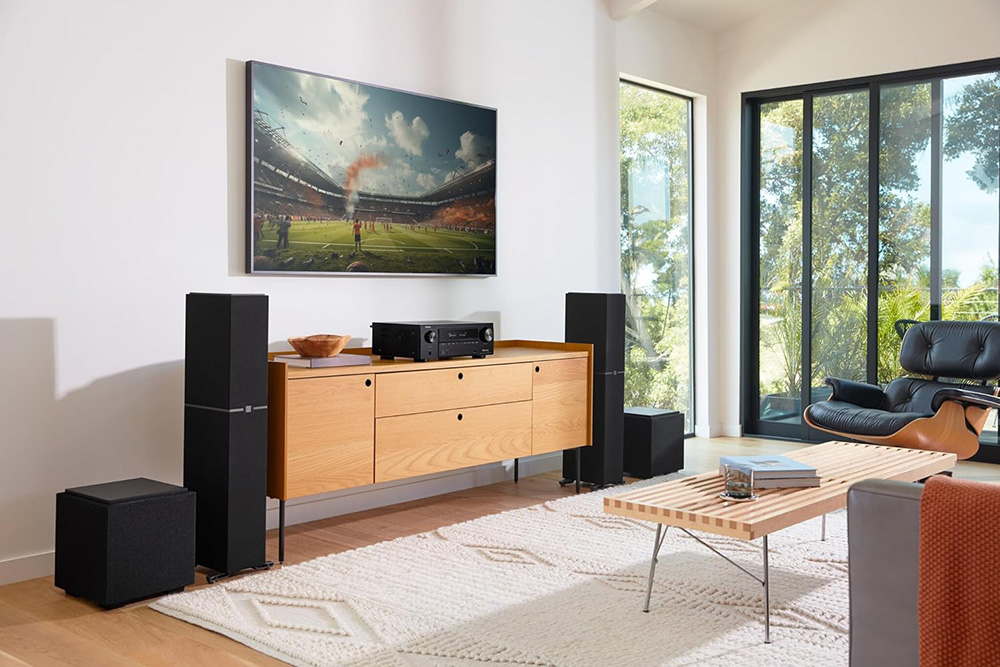
Bass
Obviously when we talk about bass the subwoofer you will use plays a huge role in what your setup can ultimately do. In our case we used an SVS SB-1000 Pro and the Denon had no problems at all sending it all the low end information needed to create a breathtaking output.
Explosions had nice weight and blasting power while gun fire felt real and raw. We may not have experienced the chest pumping effect that many like to get in their home theaters. But we had a real blast with both films during testing. And made our walls shake more than a few times!
Music Testing
In terms of music the AVR-X1800H naturally comes with an extensive list of supported files and codecs. The usual low quality ones are there like MP3, WMA and AAC. But we also get High Resolution Audio support in the likes of FLAC, WAV, Apple Lossless and DSD.
For this test we used our trusted Zidoo Z9X media player in order to stream some music files to the receiver.
Obviously getting an AV receiver like this means that movies is your first priority. But this doesn’t mean that it cannot offer a very nice music experience also.
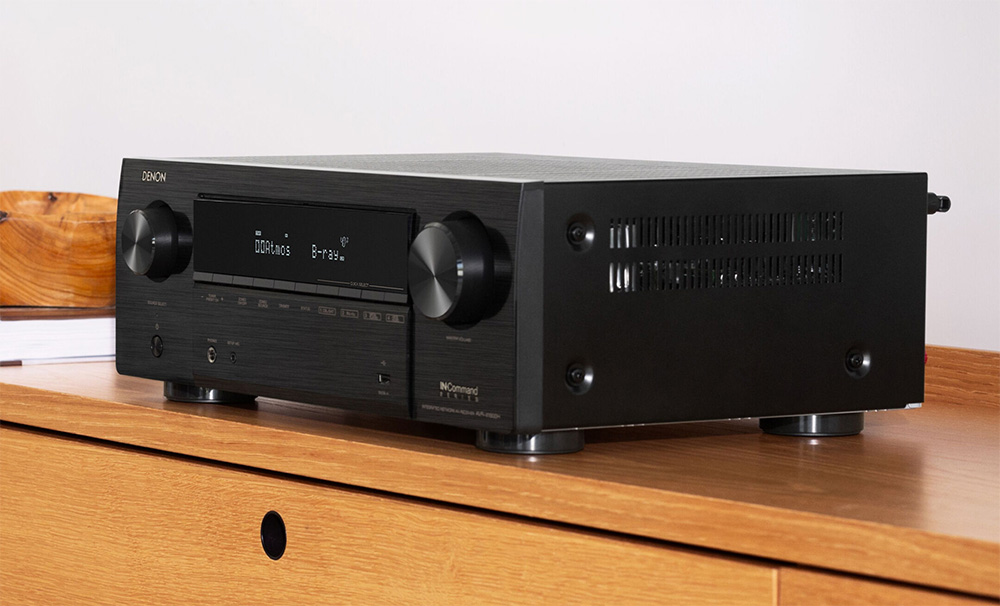
The unit may not be able to compete with high end HiFi gear. And you shouldn’t really be expecting as such. But for casual music use it can do more than fine. The receiver has good clarity and pays enough attention to details without going overboard.
Obviously pushing it to its limits will make some distortion audible. But the unit was surprisingly stable enough with losing much of its cohesiveness.
The mid-range was nicely rendered. And the high frequencies had good energy and enough emotion. The low end bits would push the tempo and keep the rhythm going without losing any of their expression and roughness.
As we usually do in these reviews we tried a few different genres to see how the Denon will behave. And we cannot say that it missed the mark in any particular one. Obviously in some very demanding songs the Denon played it safe missing some finer details. But this is something you expect to get only from dedicated HiFi equipment.
Performance Conclusion
Obviously this is not the kind of equipment that will drop your jaw to the floor. But to be honest this is not meant to do so. Its main purpose is to give you the best cinematic performance in its price category. And additionally provide you with very good music output that any casual user can appreciate.
And this is exactly what the Denon AVR-X1800H can do. It delivers in both fronts without much effort.
Connectivity
Ports Analysis and Layout
Next we will take a look at all the connections available in the unit. And after a thorough checking it seems that this is where Denon did change a few things.
But before we go in detail, let’s see what is actually there.
We already mentioned above about the frontal ports that include the Headphones jack, the setup microphone port and the USB port. The front HDMI port is still missing in action so no changes here.
Towards the bottom, there are 7 speaker terminals placed in a straight line which helps a lot with cable management. The terminals are the usual quality we have seen from Denon so all is good here, with good quality plastic caps. Keep in mind that each terminal has its own amplification.
At the top we find the HDMI inputs and here we find six of them with three of them being HDMI 2.1 while the other three are the older HDMI 2.0.
As for the rest of the connections we get 2 optical and 1 coaxial digital inputs, 1 Ethernet port, 2.2 channels pre-outs, 2 analogue audio inputs and one more dedicated for phono, a zone 2 stereo output, an IR input, a 2nd USB for power distribution and the usual FM/AM antenna inputs along with the WiFi/Bluetooth connectors.
The obvious change in the X1800H is that Denon decided to take out the composite ports completely. In return they added the 2.2 channels pre-outs and the 2nd USB port.
Taking out the composite ports was a logical move. Since the X1800H cannot up-scale analog to HDMI, their use was fairly limited. And moving to an all digital environment is something all electronic brands aim for the last few years.
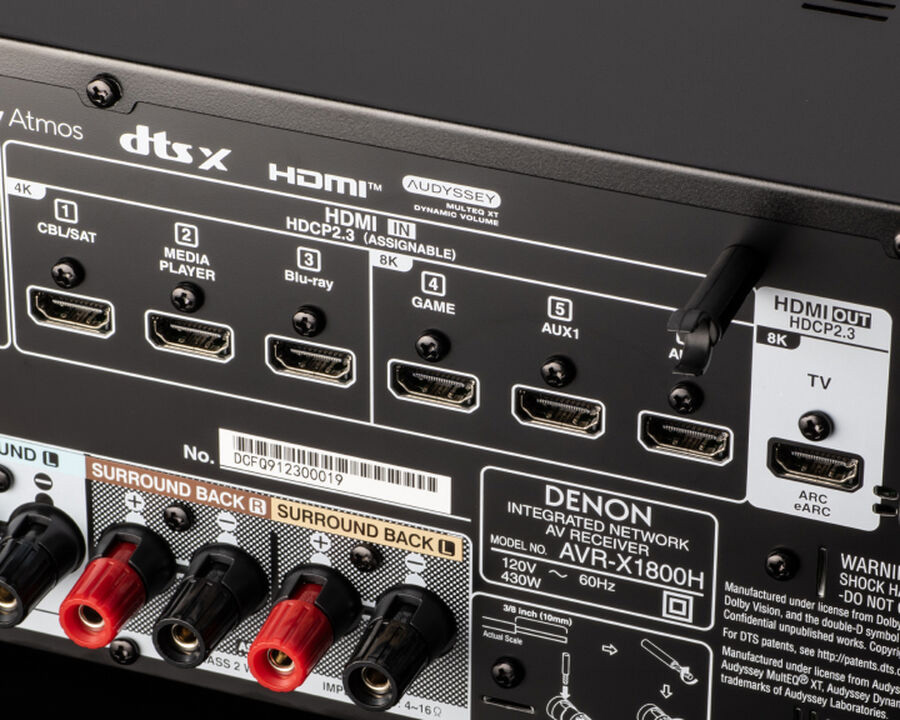
HDMI Specifications
The new X1800H comes with three HDMI 2.0 ports capable of 18Gbps and three more HDMI 2.1 ports that support all the old and new exciting technologies available today.
These include 8K/60Hz and 4K/120Hz video passthrough, 40Gbps bandwidth, 4:4:4 Pure Color sub sampling, HDR10, HDR10+, Dolby Vision, Hybrid Log-Gamma (HLG), Dynamic HDR, 3D, BT.2020 pass-through, Quick Media Switching (QMS), Variable Refresh Rate (VRR), Auto Low Latency Mode (ALLM) and Quick Frame Transport (QFT).
Just to make things clear the X1800H is obviously using a new, bug-free HDMI 2.1 chip. All the 2020 AV receivers that featured HDMI 2.1 ports came with a bugged Panasonic chip that wouldn’t allow it to pass certain signals. Like 4K/120Hz RGB signals from the Xbox series X for example, as it would result in a black screen.
The AVR-X1800H on the other hand seems to be using an updated version of this HDMI 2.1 chip which allows up to 40Gbps of bandwidth in three of its HDMI ports and this includes all the signals with a 4K@120Hz configuration including Xbox Series X.
Although we are well past this problem, we did connect both our PS5 and Xbox Series X for testing. Both consoles could pass any signal we tried including 4K@120Hz without any signal loss or HDMI handshaking problems.
Wireless Capabilities
As for the unit’s wireless capabilities we get built-in WiFi (IEEE 802.11a/b/g/n/ac) which can connect both in 2.4GHz and 5 GHz networks.
We also get Bluetooth support and it seems that Denon decided to upgrade its module as it is not v5.0 instead of the v4.2 most Denon AV receivers had until now. Unfortunately this still supports only the basic SBC codec.
OS, Apps and Features
Next we will take a look at what extras and features the receiver comes with. Looking at the entire feature list available we do not find a lot of differences or changes compared to the X1700H. So let’s go over everything available…
Audio Calibration System
And we will start with the audio calibration system. Denon is using the Audyssey system. And as with all manufacturers they scale it accordingly to meet the price and performance standards of each of their models.
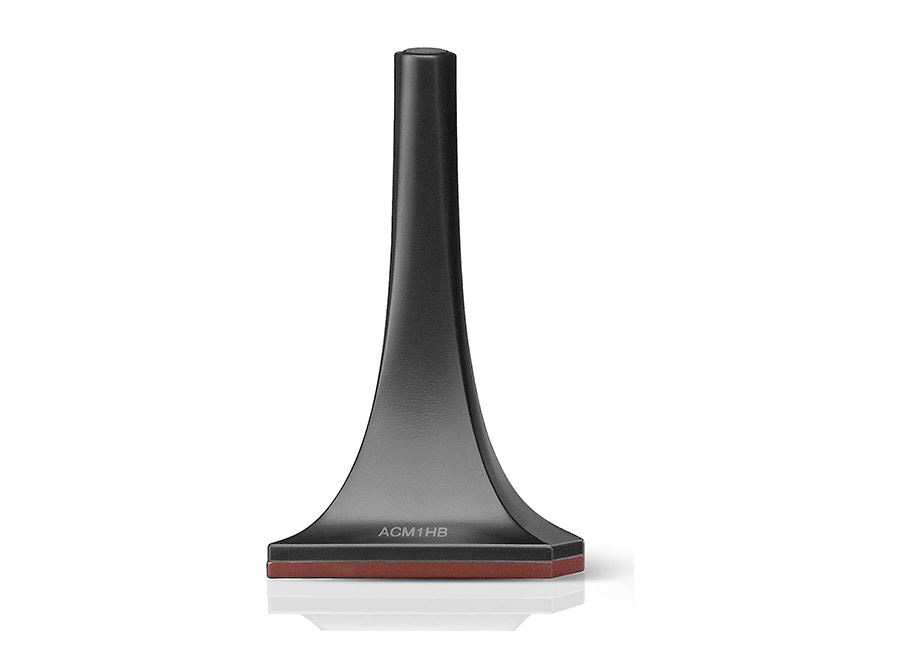
Audyssey MultEQ XT
For the X1800H we get the Audyssey MultEQ XT version which is a step lower than the XT32 version which is their best and most feature complete suite. In comparison this one features lower resolution filters which can result in less accuracy.
The Audyssey MultEQ XT also comes with the Dynamic Volume and Dynamic EQ features. This version of Audyssey has the ability to analyze up to 8 different listening positions with the help of the included microphone and creates precise digital filters in order to offer the best audio result for your particular space.
But expect from the core system we also get Dynamic EQ which is a feature that is responsible at keeping the clarity and dynamic levels of audio even when you like to watch at low volume, like for night viewings for example.
Dynamic Volume on the other hand is capable of balancing sudden changes and spikes in volume that could appear when there are sudden changes from TV broadcasting to commercials.
Audyssey calibration
Going through the Audyssey calibration can be done through the built-in wizard. If you want to dive deeper into calibrating your system then you can download the Audyssey MultEQ Editor app. Which is available for Android or iOS and do a more thorough setup with the help of your mobile device.
Only keep in mind that this app has a one time fee which is a shame, but it is what it is. As for the built-in system this is more than enough for most casual users. As it offers almost anything you need to make very good and precise adjustments to your system.
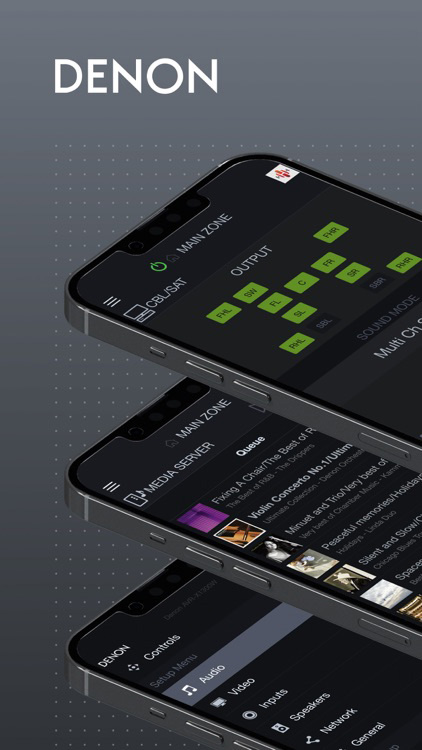
Denon AVR Remote App
But Denon provides another app for this AV receiver and this one comes completely free. The Denon AVR Remote app, as it is called, lets you control the unit with your mobile device through a nice visual interface. If you are tired of the included remote this is a nice, and most important, free alternative. The app is available for both Android and iOS devices so we suggest you give it a try to see if you like it.
User Experience
And since we mentioned the visual interface we have to talk about the updated GUI that all Denon AV receivers now have. Denon changed the UI last year in some of their new models and it seems this will be the one used for all new releases.
For some years now we were complaining about how old style and outdated the UI of the Denon AV receivers looked. It was as though it belonged in the early 2000s with its simple menus and 480p resolution.
The new menus are not all that different in terms of structure and layout. You still get the same list of features in a similar way to the old UI. But they bumped the resolution up to 1080p and made it look graphically more pleasing to the eye. Now it feels like it is something newer. And although it may not be as fancy as what smart TVs have, it is far better that what we were getting till now.
But if you like a more hands free experience, the AVR-X1800H supports all known voice control platforms. As such there is support for both most known ones with Amazon Alexa and Google Assistant. But there is also support for Apple’s Siri through the Airplay 2 app and the advanced automation system Josh.ai making this receiver complete in every way.
Lastly there is HDMI-CEC. This one lets you use the TV remote to control the AV receiver, if the TV also supports this. Obviously this feature lets you use only the most basic functions of the receiver but for everyday use it can be a very time saving feature. And you can reduce the amount of remotes you have to use every time.
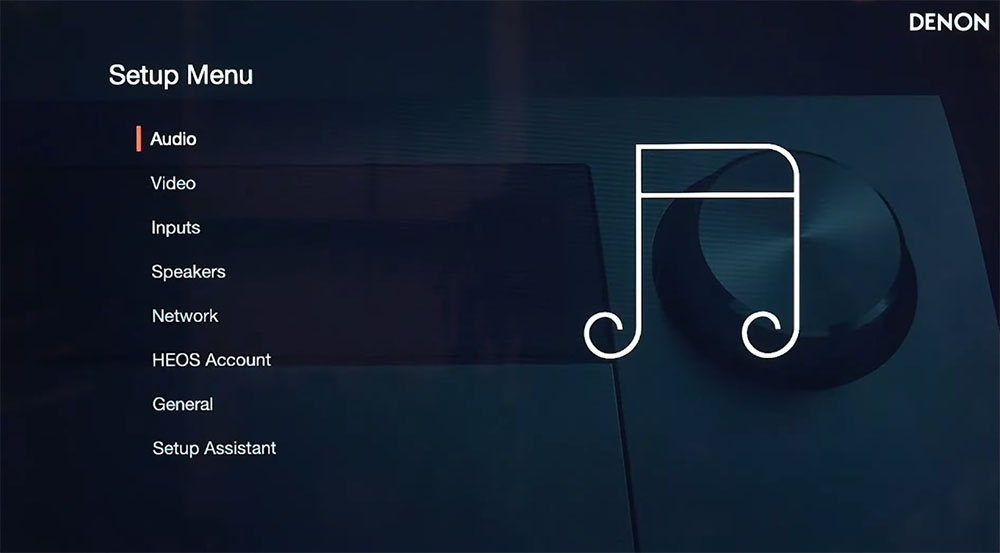
Online Streaming
In terms of streaming you get the usual we see in all Denon models.
There is both HEOS and Airplay 2 you can use to stream music online from one of the available online streaming services. These are TuneIn Internet Radio, Spotify, Pandora, Amazon Music HD, TIDAL, iHeartRADIO, Deezer, Napster and SoundCloud. Both the HEOS and Airplay 2 apps are available for downloading from their appropriate stores for use with your mobile device.
Offline Streaming
As for offline streaming, there are also plenty of options for you. You can stream audio from a network drive or NAS server if it happens you to have one connected to your local network.
Also with the included frontal USB port you can stream music through some connected external storage or flash drive. Lastly if you prefer a more wireless way of streaming your music there is Bluetooth available for connecting with your mobile device. If you use Apple devices then Airplay 2 can also be used to stream music wireless through it.
And since we mentioned Bluetooth, another function that is included in the X1800H is its ability to output sound from both the main speakers and through a Bluetooth connection. The X1800H is capable of streaming audio to Bluetooth enabled headphones for a completely silent house experience. Or it can also output sound from both its speaker terminals and to a Bluetooth headset. This can be particularly practical in case there is a member in the family that is hearing impaired.
But keep in mind that this can be used only for music and not for movies. And this happens because the Bluetooth transmitter of the AV receiver is using the SBC codec and not some more advanced variant meant for such use, like aptX Low Latency. As a result there is bound to be an audio delay due to the Bluetooth transmission speed, making this feature ideal only for music use.

Multi-Zones Capabilities
You can also create your own multi-room environment with the use of appropriate wireless speakers. But if you prefer a wired connection the AVR-X1800H also supports Zone 2 through its 2.0 channels pre-outs now available at the back of the unit.
Various Other Features
There are plenty more extras and features Denon includes in all their releases. So let’s go over them real quick.
The receiver supports video upscaling to 8K resolution. But the obvious limitation here is that the X1800H can do that only through its HDMI ports as all analog ports are taken out. We also get an ECO mode that can regulate the receiver’s power usage as well as being “Roon Tested” certified.
For this last one there seems to be a bit of confusion. As there are two types of certifications. Roon Ready and Roon Tested. The AVR-X1800H, as with all Denon AV receivers, is Roon Tested.
This means that while Roon will work on this unit, you will not get the highest quality possible. So for example if you use Airplay, audio quality is limited to 16 Bit/44.1kHz. Keep that in mind in case Roon is specifically important to you but also want your files to be streamed in their original quality.
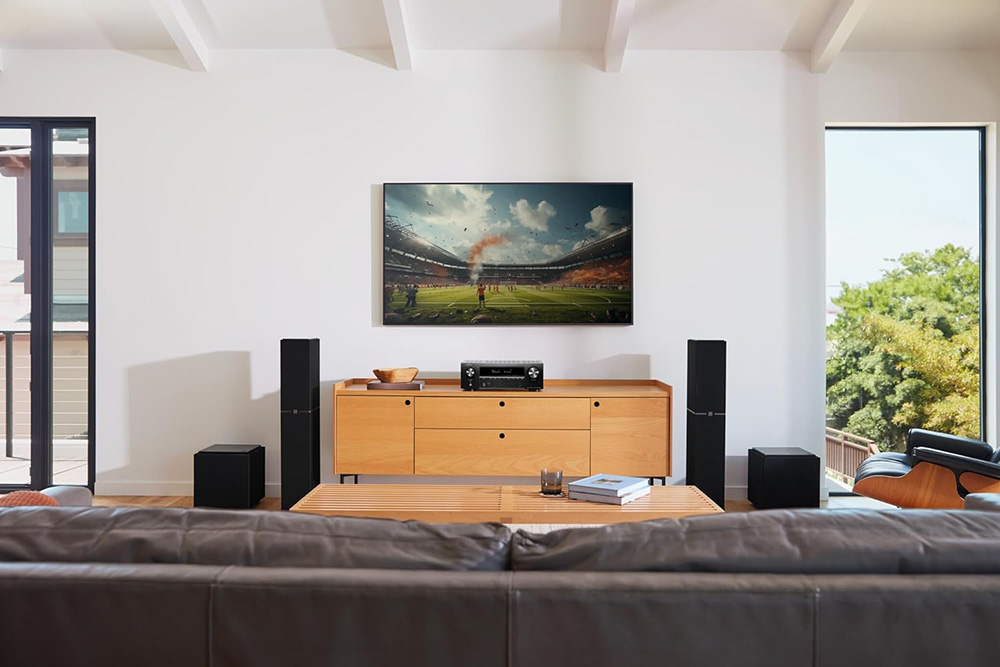
Compared to Other AV Receivers
The comparison most people will ask for is with its predecessor, the Denon AVR-X1700H. To be honest, after going through everything, we can say with certainty that these two units are 99% the same. The only meaningful differences are the omission of the composite ports, the addition of the 2.2 channels pre-outs and the rear USB port, the slightly different remote and the updated user interface. With these in mind if you can find the X1700H at a lower price then this is the obvious choice.
A very good alternative at almost the same price is the Onkyo TX-NR6100. The Onkyo has higher power output at 100 watts and comes with THX certification. The only downside is that it’s not easy to find one in stock.
Another very good option is the new Sony STR-AN1000. It is slightly more expensive but the Sony offers more. You get 100 watts of power output and additionally supports IMAX Enhanced, 360 Reality Audio and MPEG-H Audio. The only downside is that it has 2 HDMI 2.1 inputs instead of the 3 the Denon has.
Last but not least there is the Yamaha RX-V6A. The RX-V6A is cheaper than the Denon and can output 100 watts of power but otherwise they have very similar specs and features.
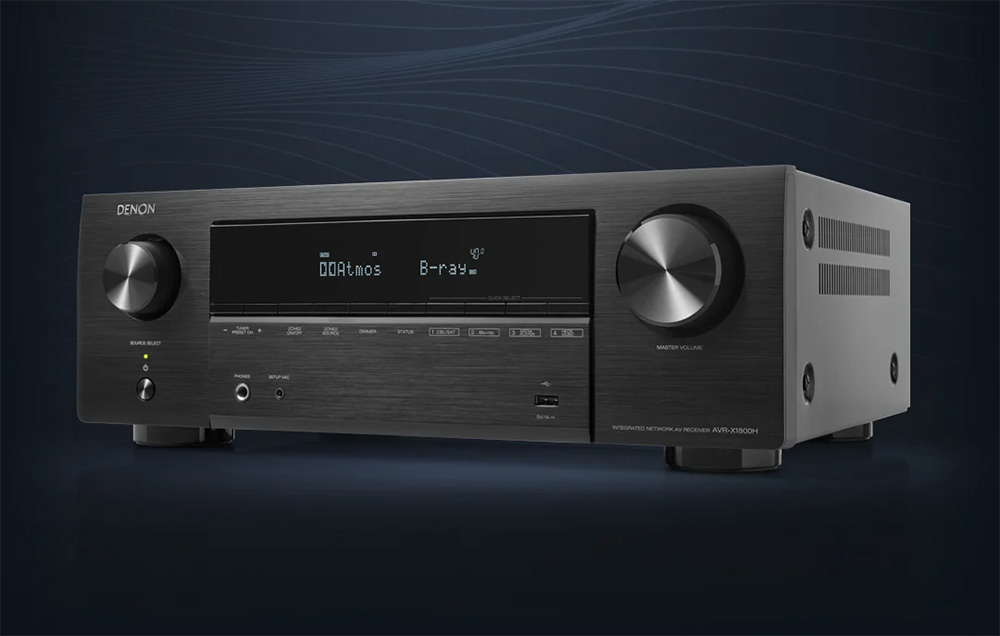
Final Thoughts
Denon is definitely one of the first brands that comes to mind with home theater AV receivers. Unfortunately not all their new models come with meaningful changes as some units are re-released with only minor tweaks. And the X1800H seems to be such a model.
This unit is a solid entry in the X-series of receivers. It comes with all the features you may ask for its category and there is nothing really bad to say about it. Its performance was stellar, it comes with 3 bug-free HDMI 2.1 ports and its online and offline streaming capabilities are undeniable.
On the downsides, Denon could do much more with this new unit. Sony proved that you can add plenty new features in this price range but instead they decided to keep everything the same. The design is also getting a bit old and is in need of a refresh.
Finishing our Denon AVR-X1800H review we can call this AV receiver a missed opportunity. The unit is every bit as good as its predecessor but Denon could do so much more with it. But its core cinematic excellence is still there and will surely offer you plenty of hours of home entertainment.
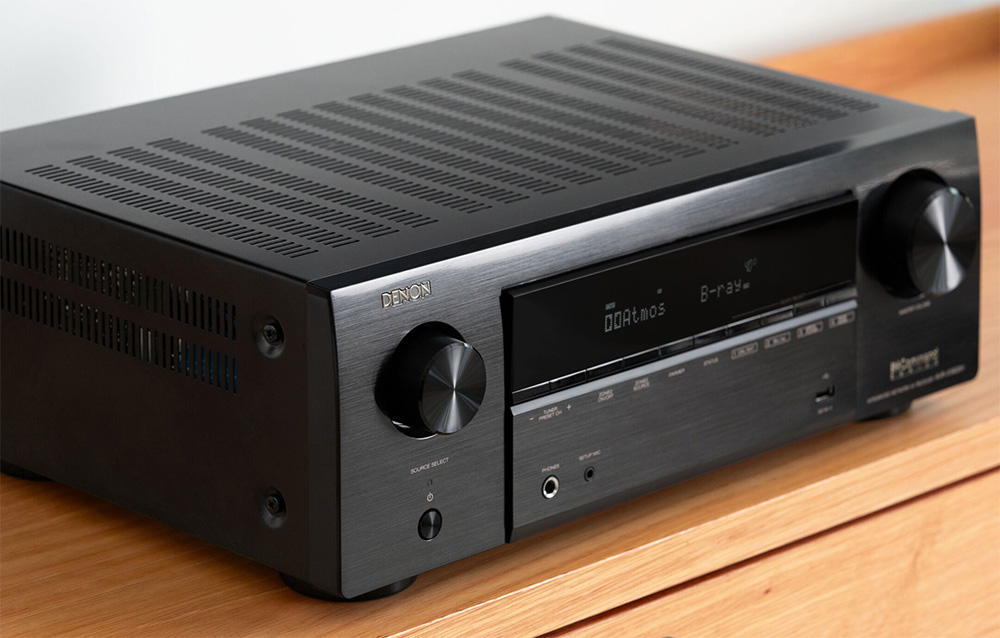
For more reviews you can check our dedicated 7 channels 8K AV Receiver reviews list or even look at our Product Reviews Table where you can find the brand and specific product you are looking for.
Cheapest Places to Buy :
*We are a reader-supported website. When you buy through links on our site, we may earn a small affiliate commission at no extra cost to you. Home Media Entertainment does not accept money for reviews.*






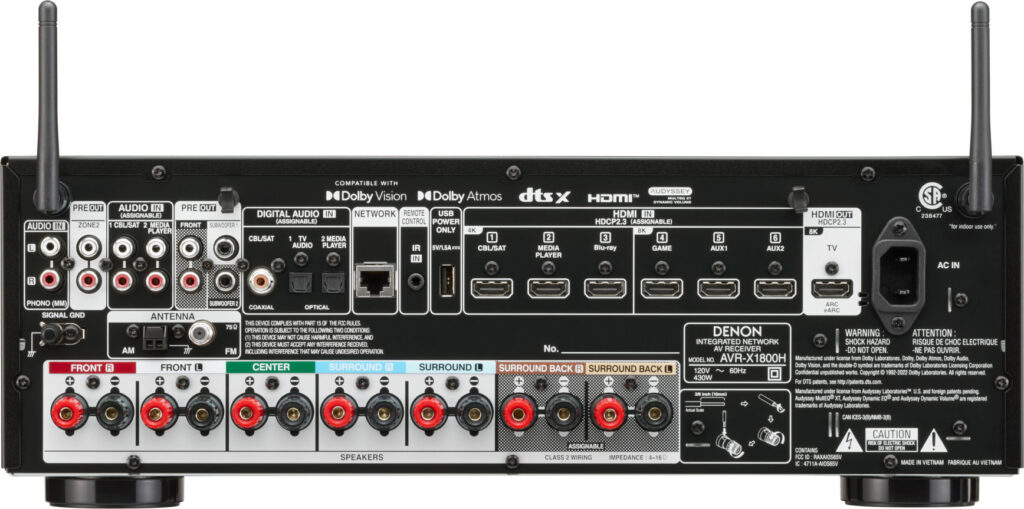
I don’t understand why Denon had to release a renamed X1700H. They could wait a bit longer and try to actually improve it a bit. Why do they have to just slap a new name on it and release it just like that? And the X1800H is even more expensive than the X1700H for no reason!
Hey Kevin. I think they did this mostly for parity reasons. They had almost the entire Xx800H out last year so they wanted to add the X1800H in the series with the rest.
Nice and thorough review Stratos. So from what I see the differences with the 1700 is negligible. I think I have seen the 1700 still in circulation and with the new one now in the market hopefully we will see some nice clearance prices. It will be a huge opportunity to find one on discount now with the holidays around the corner.
Surely, if you can find one at a lower price it can be a good opportunity. The two receivers are basically the same.
I needed the pre-outs. Got the $200 off holiday discount which made this perfect for my bedroom system.
Nice discount Vince. I hope you enjoy it! If you need any assistance let me know 😉